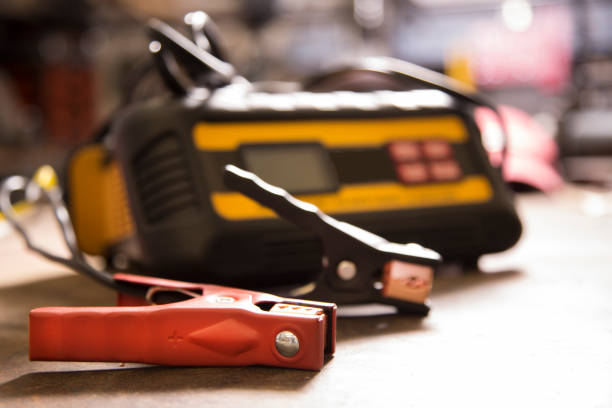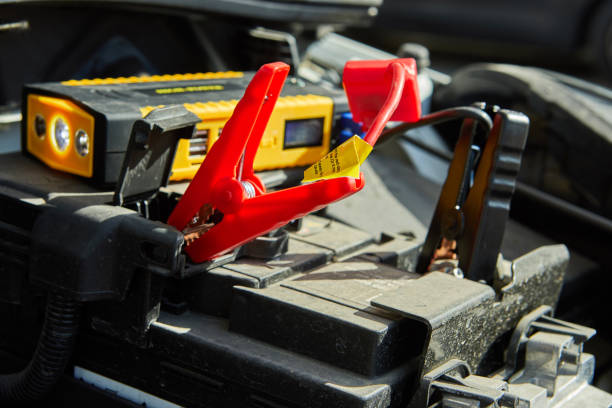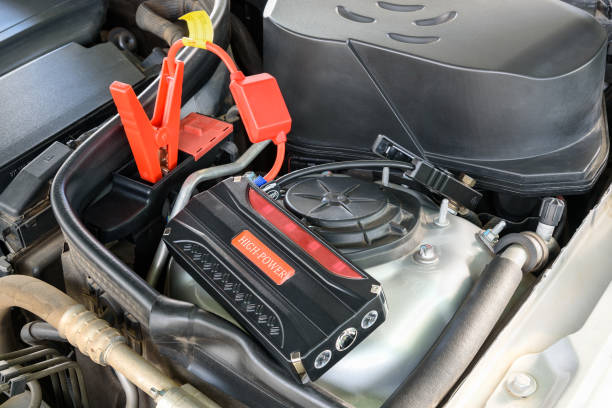
Ever wonder about the benefits of portable jump starters. Did you know that every 53 seconds, a driver in the U.S. faces a dead car battery – enough to strand 1.2 million Americans annually. Unlike traditional jumper cables requiring another vehicle, modern solutions let you restart your engine solo in minutes.
These palm-sized power banks store enough energy to revive most vehicles, from sedans to trucks. Their built-in safety systems prevent dangerous sparks while delivering precise voltage to protect sensitive electronics.
Many models include life-saving extras like USB charging ports and LED floodlights. Compact designs slip easily under seats, eliminating bulky equipment that collects dust. Roadside assistance services‘ wait times average 45 minutes – these gadgets solve problems before tow trucks arrive.
Urban commuters and rural travelers alike benefit from carrying this essential roadside companion. Recent improvements in lithium-ion technology make these tools more powerful than ever, with some models fitting in glove compartments.
Modern drivers no longer need to wave down strangers for emergency boosts. Today’s compact power solutions, like jump starters and air compressor, combine engineering smarts with user-friendly designs, turning complex electrical processes into simple safety nets for your car.
When your car won’t start and you’re miles from help, knowing how to use portable jump starters or relying on battery jumpstart services can save you time and stress on the road.
Think of these gadgets as emergency power banks for your car. Unlike traditional cables, they store enough energy to kickstart engines independently. Most units weigh less than 3 pounds yet pack enough punch to revive trucks and SUVs.
Three core elements make them work:
When your emergency car’s battery dies, the device becomes a temporary power source. Its internal battery sends energy through thick cables to the vehicle’s terminals. Advanced models automatically adjust voltage to match engine requirements.
Safety features prevent sparks during connection. “The clamps won’t transfer current until they detect proper polarity,” explains automotive technician Mark Sullivan. This protects both your vehicle’s electronics and the jump starter itself.
Compact versions fit in motorcycle saddlebags, while heavy-duty units handle diesel engines. Many now include USB ports for charging phones – a bonus during roadside emergencies.
Stranded drivers face two critical challenges: finding help and accessing their car’s power source. Portable solutions transform these stressful situations through smart engineering and compact design.
Traditional jumper cables leave you at the mercy of passing traffic. In rural areas, 62% of drivers wait over an hour for roadside assistance. A self-contained jump starter bypasses this wait, delivering 400-2000 cold cranking amps directly to your engine.
Urban parking garages showcase another advantage. “You can’t maneuver donor cars in tight spaces,” notes AAA technician Laura Chen. These portable devices allow you to jump-start a car without needing another vehicle, making them ideal for confined areas.”These devices work whether you’re boxed in or facing a concrete wall.”
Modern vehicle layouts often hide batteries under complex panels or in tight compartments. Jump starter units only require:
This flexibility proves vital when terminals are obstructed. Unlike traditional methods needing direct battery-to-battery contact, jump starters can transfer power through alternative grounding points.
| Feature | Portable Starter | Traditional Cables |
|---|---|---|
| Space Required | Hood clearance | Two vehicle alignment |
| Assistance Needed | None | Donor vehicle |
| Setup Time | 2-4 minutes | 10-15 minutes |
| Remote Area Use | Full capability | Impossible |
The table above highlights why 78% of users report faster resolutions with portable units. Drivers maintain control regardless of location or parking constraints with their car jump starter portable.
Automotive emergencies demand solutions that prioritize user protection while simplifying complex procedures. Modern jump starters transform risky electrical work into secure, intuitive processes through intelligent engineering.

Advanced models eliminate common dangers with three key safeguards:
“These devices act like a digital safety net,” explains electrical engineer Rachel Torres. “They won’t activate until confirming proper setup, unlike traditional cables that transfer power immediately.”
Reverse polarity protection stops 92% of user errors from causing damage.
Using a jump starter requires four simple steps:
| Factor | Jump Starter | Jumper Cables |
|---|---|---|
| Setup Time | 90 seconds | 15+ minutes |
| Required Knowledge | Basic color matching | Electrical expertise |
| Error Prevention | Automatic | Manual checks |
| Post-Use Maintenance | Recharge unit | Untangle/store cables |
Traditional methods demand precise terminal alignment and donor vehicle coordination. Many drivers struggle with proper cable connection sequences, increasing accident risks. Modern starters remove these challenges through foolproof designs.
Emergency situations become less stressful when your solution works like charging a phone. Clear indicators and automatic adjustments let anyone revive a dead battery and ensure that your starters are ready to go safely – no mechanic skills required.
Today’s compact power units do more than revive engines – they serve as mobile command centers for vehicle emergencies. Manufacturers now pack these devices with practical tools that handle multiple roadside scenarios.

Built-in LED flashlights transform night-time breakdowns into manageable situations. High-lumen beams illuminate engine compartments and create visible safety perimeters. “These aren’t ordinary lights – they can signal help from ¼ mile away,” notes outdoor safety expert Gina Marquez.
Dual-purpose USB ports keep phones and navigation systems operational during extended waits. Premium models feature:
Integrated air compressors solve two problems simultaneously – dead batteries and flat tires. These air compressor features are essential for car jump scenarios, ensuring digital pressure gauges provide accurate inflation for:
Top-tier units add professional-grade extras like compasses and laptop adapters. This table shows feature distribution across popular models:
| Feature | Basic Models | Premium Models |
|---|---|---|
| Air Compressor | ✓ | ✓ |
| USB Ports | 2 | 4+ |
| LED Brightness | 200 lumens | 500+ lumens |
| Special Features | – | Compass/Inverter |
These multi-tool designs reduce trunk clutter while preparing drivers for unexpected challenges. What begins as a battery booster for dead batteries becomes your first responder, equipped with an air compressor for diverse roadside situations.
Having the best jump starter for cars ensures you’re always prepared for emergencies, giving you the convenience and peace of mind to handle a dead battery anytime, anywhere.
Automotive power solutions have shifted dramatically with lithium technology becoming the new gold standard for jump starters. These jump starter units outperform older designs through smarter energy management and space-efficient engineering.
Lithium units store 3x more power per pound than lead-acid counterparts. A 1-pound lithium model often matches the output of a 5-pound traditional unit. This lets drivers store serious energy in glove compartments without sacrificing cargo space.
While lead-acid batteries need 8+ hours to recharge, lithium versions restore full power during lunch breaks. “You can top up most models faster than charging a smartphone,” says battery engineer Dr. Ellen Park. Built-in circuits prevent overcharging, extending the device’s lifespan.
| Feature | Lithium | Lead-Acid |
|---|---|---|
| Weight | 0.8-2 lbs | 3-7 lbs |
| Recharge Time | 1-3 hours | 8-12 hours |
| Monthly Charge Loss | <2% | 5-8% |
| Cycle Life | 500+ starts | 100-200 starts |
Lithium’s self-discharge rate keeps units ready for emergencies even after months in storage. Unlike lead-acid batteries that degrade when drained completely, lithium models handle deep discharges without permanent damage.
“The cycle life difference alone makes lithium starters more cost-effective over time,” notes automotive analyst Michael Reeves. “You’re replacing cables every few years versus a decade with lithium.”
Modern power solutions adapt to diverse transportation needs, eliminating “one-size-fits-all” limitations. Whether navigating city streets or wilderness trails, these tools deliver reliable performance across engine sizes and environments.
Compact cars and heavy-duty trucks both benefit from smart energy management. Units designed for SUVs often pack 2000+ peak amps – enough to revive 8-cylinder engines. Motorcycle owners appreciate models that fit in saddlebags yet still jump-start 1200cc bikes.
Marine applications prove equally effective. Boaters use waterproof units to restart 12-volt systems during fishing trips. Farmers rely on them for tractors and generators when working remote fields.
Back road emergencies demand self-sufficient solutions. Unlike traditional methods requiring donor vehicles, portable jump starters work where cell signals fail. Their sealed designs withstand dust storms, while temperature-resistant batteries operate in -4°F to 140°F conditions.
Campers and off-roaders report successful engine starts even after weeks of storage. “We’ve revived ATVs buried in snow using the same unit that jump-starts our truck,” says Colorado adventurer Liam Carter. Multi-purpose functionality turns dead car situations into brief delays rather than trip-ending disasters.
A portable starter is a compact, self-contained device that provides enough power to revive a dead car battery. Unlike traditional jumper cables, this jump starter portable doesn’t require another vehicle, making it ideal for home emergencies. These starter portable devices offer convenience, ensuring you can tackle unexpected situations with ease.
These devices store energy in an internal battery. When connected to a dead car battery, they deliver a surge of power to crank the engine. Many models include safety features like reverse polarity protection to prevent damage.
Yes. Many modern lithium jump starters are designed to handle engines in trucks, SUVs, and even some RVs. Always check the product’s peak amperage rating to ensure compatibility with your vehicle.
Absolutely. Built-in safeguards jump starter portable like spark-proof clamps, overcharge protection, and short-circuit prevention reduce risks. They eliminate the need for positioning two vehicles close together, which can be hazardous.
Many models include USB ports for charging phones, built-in LED flashlights for emergencies, and even air compressors for tires. This multipurpose functionality makes them valuable tools for road trips.
Lithium units are lighter, charge faster, and offer higher energy density. They’re easier to store in a trunk and perform better in extreme temperatures compared to bulkier lead-acid versions.
Most lithium models recharge fully in 2–4 hours via a wall outlet or car charger. Some advanced units support fast charging, reaching 80% capacity in under an hour.
Yes. Their standalone design makes them perfect for remote locations where finding another vehicle for a jump-start isn’t feasible. Look for rugged models with water resistance for tough conditions.
Portable starters eliminate the need to reach the battery directly in many cases. Some vehicles allow connection via designated terminals under the hood, simplifying the process.
No, but many premium models do. If tire inflation is a priority, check product specs needs for integrated compressors. These add-ons are handy for maintaining proper tire pressure on the go.
Request Emergency Roadside Assistance
Use the form here and we’ll respond as quickly as possible or call the number displayed.